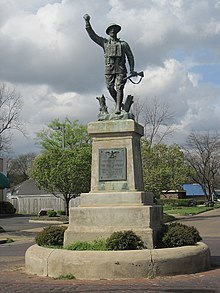
Swanton is a village located in Fulton and Lucas counties in the U.S. state of Ohio. The population was 3,897 at the 2020 census. Total area is 8.90 km2.

John Gutzon de la Mothe Borglum was an American sculptor best known for his work on Mount Rushmore. He is also associated with various other public works of art across the U.S., including Stone Mountain in Georgia, the statue of Union General Philip Sheridan in Washington, D.C., as well as a bust of Abraham Lincoln which was exhibited in the White House by Theodore Roosevelt and which is now held in the United States Capitol crypt in Washington, D.C.
John Seward Johnson II, also known as J. Seward Johnson Jr. and Seward Johnson, was an American artist known for trompe-l'œil painted bronze statues. He was a grandson of Robert Wood Johnson I, the co-founder of Johnson & Johnson, and of Colonel Thomas Melville Dill of Bermuda.
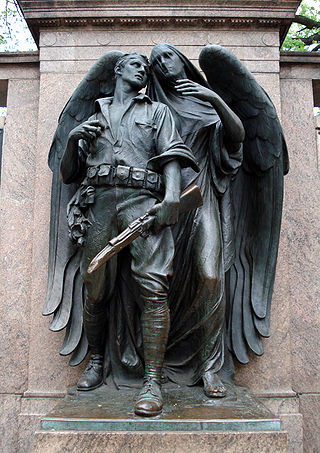
Henry Augustus Lukeman was an American sculptor, specializing in historical monuments. Noted among his works are the World War I monument in Prospect Park, Brooklyn, the Kit Carson Monument in Trinidad, Colorado and the Stone Mountain Confederate Memorial in Georgia.
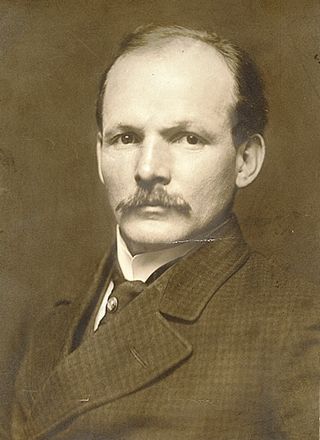
Solon Hannibal de la Mothe Borglum was an American sculptor. He is most noted for his depiction of frontier life, and especially his experience with cowboys and native Americans.

The Albert Einstein Memorial is a monumental bronze statue by sculptor Robert Berks, depicting Albert Einstein seated with manuscript papers in hand. It is located in central Washington, D.C., United States, in a grove of trees at the southwest corner of the grounds of the National Academy of Sciences at 2101 Constitution Avenue N.W., near the Vietnam Veterans Memorial. Two replicas exist at the Israel Academy of Sciences and Humanities and the Georgia Institute of Technology.

Iron Mike is the de facto name of various monuments commemorating servicemen of the United States military. The term "Iron Mike" is uniquely American slang used to refer to men who are especially tough, brave, and inspiring; it was originally a nautical term for a gyrocompass, used to keep a ship on an unwavering course. Because the use of the slang term was popular in the first half of the 20th century, many statues from that period acquired the Iron Mike nickname, and over the generations the artists' titles were largely forgotten. Even official military publications and classroom texts tend to prefer the nickname to the original titles.

Fallen Astronaut is a 3.5-inch (8.9 cm) aluminum sculpture created by Belgian artist Paul Van Hoeydonck. It is a stylized figure of an astronaut in a spacesuit, intended to commemorate the astronauts and cosmonauts who have died in the advancement of space exploration. It was commissioned and placed on the Moon by the crew of Apollo 15 at Hadley Rille on August 2, 1971, UTC, next to a plaque listing 14 names of those who died up to that time. The statue lies on the ground among several footprints.

Ernest Moore Viquesney was an American sculptor best known for his popular World War I monument Spirit of the American Doughboy.

Burt William Johnson was an American sculptor.
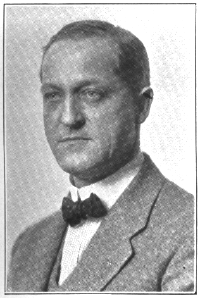
John Paulding was an American sculptor best remembered for his World War I memorials. Paulding was born in Darke County, Ohio. He studied sculpture at the Art Institute of Chicago and was to remain in Chicago until his death at an early age in 1935.

John Clements Gregory was an American sculptor.

General Philip Sheridan is a bronze sculpture that honors Civil War general Philip Sheridan. The monument was sculpted by Gutzon Borglum, best known for his design of Mount Rushmore. Dedicated in 1908, dignitaries in attendance at the unveiling ceremony included President Theodore Roosevelt, members of the President's cabinet, high-ranking military officers and veterans from the Civil War and Spanish–American War. The equestrian statue is located in the center of Sheridan Circle in the Sheridan-Kalorama neighborhood of Washington, D.C. The bronze statue, surrounded by a plaza and park, is one of eighteen Civil War monuments in Washington, D.C., which were collectively listed on the National Register of Historic Places in 1978. The sculpture and surrounding park are owned and maintained by the National Park Service, a federal agency of the Interior Department.
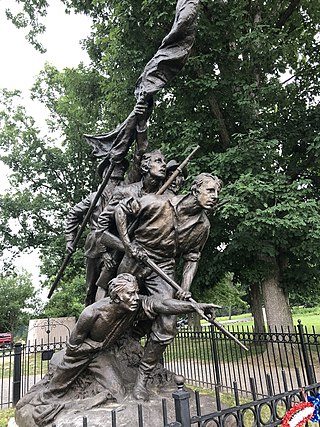
The North Carolina Monument is a North Carolina memorial of the American Civil War commemorating the 32 Carolina regiments in action at the Battle of Gettysburg. The monument is a public artwork by American sculptor Gutzon Borglum located on Seminary Ridge, West Confederate Avenue, in the Gettysburg National Military Park.
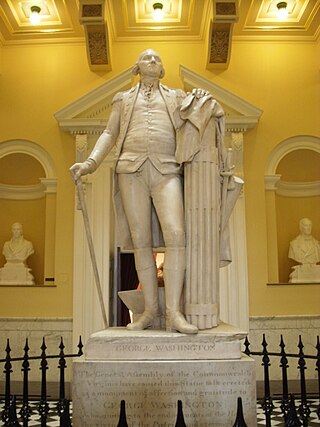
George Washington is a statue by the French sculptor Jean-Antoine Houdon from the late 18th century. Based on a life mask and other measurements of George Washington taken by Houdon, it is considered one of the most accurate depictions of the subject. The original sculpture is located in the rotunda of the Virginia State Capitol in Richmond, Virginia, and it has been copied extensively, with one copy standing in the United States Capitol Rotunda.
Spirit of the American Navy was a World War I monument created by sculptor E. M. Viquesney in 1927. It was intended to be a companion piece to his very popular, Spirit of the American Doughboy, but never attained that stature, occurring in only seven known locations, with an eighth held in private ownership.

Pietro Montana was a 20th-century Italian-American sculptor, painter and teacher, noted for his war memorials and religious works.

Joan of Arc, also known as Joan of Arc, Maiden of Orleans, is an outdoor copy of Emmanuel Frémiet's equestrian statue Jeanne d'Arc (1874), installed in Portland, Oregon's Laurelhurst neighborhood, in the United States. The bronze sculpture, which depicts Joan of Arc, was donated to the city by Henry Waldo Coe, who saw Frémiet's original statue in Paris. Portland's copy arrived from France in 1924 and was dedicated on Memorial Day in 1925 in honor of the Doughboys of World War I.

American Doughboy Bringing Home Victory, also known as Armistice and Spirit of the American Doughboy, is an outdoor 1932 bronze sculpture and war memorial by Alonzo Victor Lewis. The statue is 12.0 feet (3.7 m) tall and weighs 4,600 pounds (2,100 kg).

Tanagra is a polychromic marble sculpture created by French artist Jean-Léon Gérôme (1824-1904) as a personification of the "spirit of Tanagra," his own mythic invention tied to the Tanagra figurines from the village of that name in ancient Greece. The sculpture was first shown at the Paris Salon of 1890. Gérôme subsequently created smaller, gilded bronze versions of Tanagra; several versions of the "Hoop Dancer" figurine held by Tanagra; two paintings of an imaginary ancient Tanagra workshop; and two self-portraits of himself sculpting Tanagra from a living model in his Paris atelier. These sculptures and paintings comprise a complex, self-referential artistic program in which one of the most celebrated artists of his generation explored reception of Classical antiquity, creative inspiration, doppelgängers, and female beauty.

